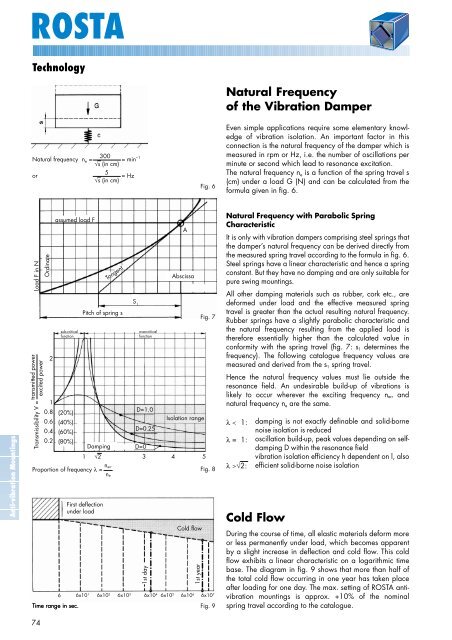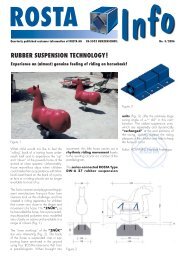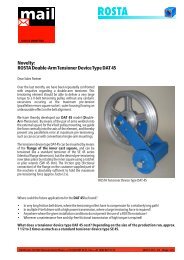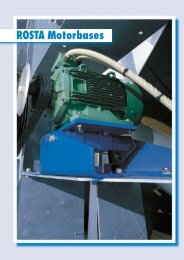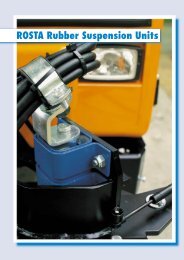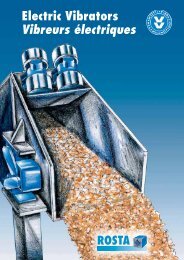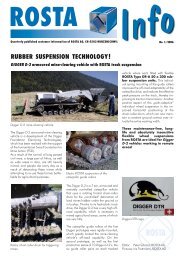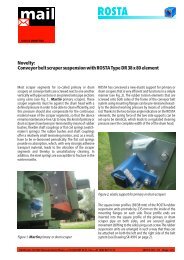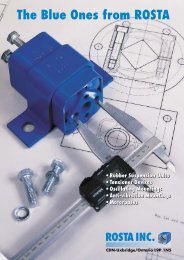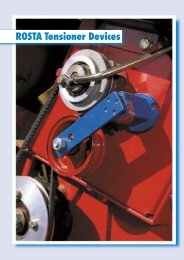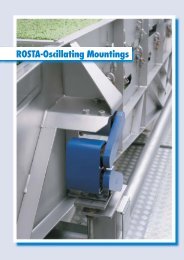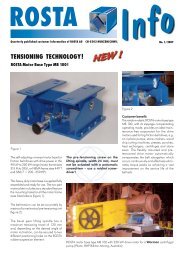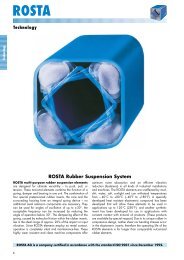ROSTA Anti-vibration Mountings - ROSTA Inc.
ROSTA Anti-vibration Mountings - ROSTA Inc.
ROSTA Anti-vibration Mountings - ROSTA Inc.
Create successful ePaper yourself
Turn your PDF publications into a flip-book with our unique Google optimized e-Paper software.
<strong>ROSTA</strong><br />
Technology<br />
Natural Frequency<br />
of the Vibration Damper<br />
300<br />
Natural frequency n e =<br />
= min –1<br />
√s (in cm)<br />
5<br />
or<br />
= Hz<br />
√s (in cm)<br />
Fig. 6<br />
Even simple applications require some elementary knowledge<br />
of <strong>vibration</strong> isolation. An important factor in this<br />
connection is the natural frequency of the damper which is<br />
measured in rpm or Hz, i.e. the number of oscillations per<br />
minute or second which lead to resonance excitation.<br />
The natural frequency n e is a function of the spring travel s<br />
(cm) under a load G (N) and can be calculated from the<br />
formula given in fig. 6.<br />
<strong>Anti</strong>-<strong>vibration</strong> <strong>Mountings</strong><br />
Load F in N<br />
transmitted power<br />
excited power<br />
Transmissibility V =<br />
Ordinate<br />
2<br />
1<br />
0.8<br />
0.6<br />
0.4<br />
0.2<br />
assumed load F<br />
sub-critical<br />
function<br />
(20%)<br />
(40%)<br />
(60%)<br />
(80%)<br />
Proportion of frequency λ = n err<br />
n e<br />
Time range in sec.<br />
Tangent<br />
Pitch of spring s<br />
Damping<br />
S 1<br />
1<br />
1 √2<br />
3 4 5<br />
First deflection<br />
under load<br />
overcritical<br />
function<br />
D=1.0<br />
D=0.25<br />
D=0<br />
1st day<br />
Abscissa<br />
Isolation range<br />
Cold flow<br />
1st year<br />
Fig. 7<br />
Fig. 8<br />
6 6x10 1 6x10 2 6x10 3 6x10 4 6x10 5 6x10 6 6x10 7<br />
A<br />
Fig. 9<br />
Natural Frequency with Parabolic Spring<br />
Characteristic<br />
It is only with <strong>vibration</strong> dampers comprising steel springs that<br />
the damper’s natural frequency can be derived directly from<br />
the measured spring travel according to the formula in fig. 6.<br />
Steel springs have a linear characteristic and hence a spring<br />
constant. But they have no damping and are only suitable for<br />
pure swing mountings.<br />
All other damping materials such as rubber, cork etc., are<br />
deformed under load and the effective measured spring<br />
travel is greater than the actual resulting natural frequency.<br />
Rubber springs have a slightly parabolic characteristic and<br />
the natural frequency resulting from the applied load is<br />
therefore essentially higher than the calculated value in<br />
conformity with the spring travel (fig. 7: s 1 determines the<br />
frequency). The following catalogue frequency values are<br />
measured and derived from the s 1 spring travel.<br />
Hence the natural frequency values must lie outside the<br />
resonance field. An undesirable build-up of <strong>vibration</strong>s is<br />
likely to occur wherever the exciting frequency n err and<br />
natural frequency n e are the same.<br />
λ < 1:<br />
λ = 1:<br />
λ >√2:<br />
damping is not exactly definable and solid-borne<br />
noise isolation is reduced<br />
oscillation build-up, peak values depending on selfdamping<br />
D within the resonance field<br />
<strong>vibration</strong> isolation efficiency h dependent on l, also<br />
efficient solid-borne noise isolation<br />
Cold Flow<br />
During the course of time, all elastic materials deform more<br />
or less permanently under load, which becomes apparent<br />
by a slight increase in deflection and cold flow. This cold<br />
flow exhibits a linear characteristic on a logarithmic time<br />
base. The diagram in fig. 9 shows that more than half of<br />
the total cold flow occurring in one year has taken place<br />
after loading for one day. The max. setting of <strong>ROSTA</strong> anti<strong>vibration</strong><br />
mountings is approx. +10% of the nominal<br />
spring travel according to the catalogue.<br />
74


